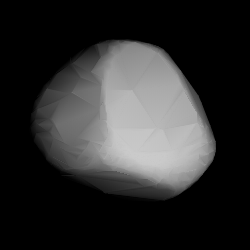 Shape model of Campanula from its lightcurve | |
| Discovery [1] | |
|---|---|
| Discovered by | K. Reinmuth |
| Discovery site | Heidelberg Obs. |
| Discovery date | 6 October 1926 |
| Designations | |
| (1077) Campanula | |
| Pronunciation | /kæmˈpænjʊlə/ [2] |
Named after | Campanula (bellflower) [3] |
| 1926 TK ·1957 AJ 1972 CB | |
| main-belt ·(inner) Erigone [4] | |
| Orbital characteristics [1] | |
| Epoch 4 September 2017 (JD 2458000.5) | |
| Uncertainty parameter 0 | |
| Observation arc | 90.56 yr (33,077 days) |
| Aphelion | 2.8655 AU |
| Perihelion | 1.9220 AU |
| 2.3938 AU | |
| Eccentricity | 0.1971 |
| 3.70 yr (1,353 days) | |
| 218.36° | |
| 0° 15m 57.96s / day | |
| Inclination | 5.3941° |
| 346.20° | |
| 13.591° | |
| Physical characteristics | |
| 7.55±1.72 km [5] 9±2 km [6] 9.709±0.278 km [7] [8] | |
| 3.847±0.002 h [a] 3.850±0.001 h [9] [10] 3.850486±0.000001 h [11] 3.85085±0.00005 h [6] 3.852±0.002 h [12] | |
Pole ecliptic latitude | |
| 0.225±0.017 [7] 0.2253±0.0169 [8] 0.33±0.12 [5] | |
| S [4] V–R = 0.400±0.070 [6] | |
| 12.3 [14] [1] | |
1077 Campanula, provisional designation 1926 TK, is a presumed Erigonian asteroid, approximately 9 kilometers (5.6 miles) in diameter, located in the inner region of the asteroid belt. It was discovered on 6 October 1926, by German astronomer Karl Reinmuth at the Heidelberg Observatory in southwest Germany. [14] The asteroid was named after the bellflower Campanula. [3]